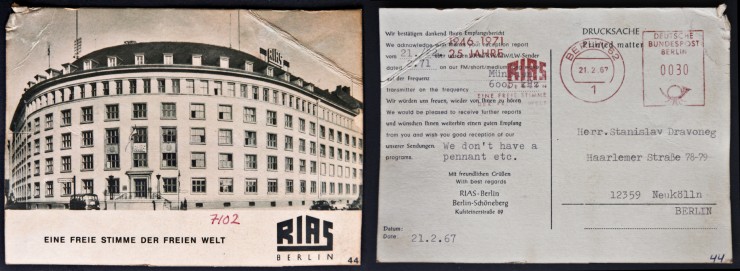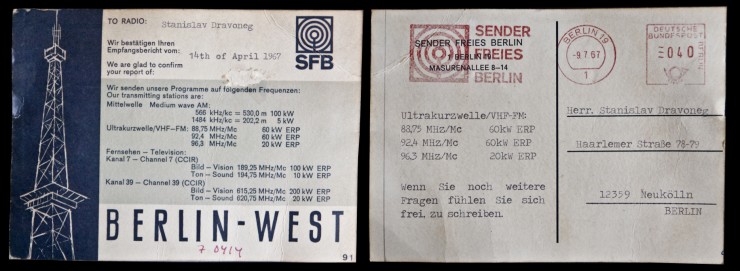Deutschland radio Kultur
RIAS & EAST Berlin radio

In 1964, Walter Ulbricht, leader of the Socialist Unity Party which governed East Germany, decided to allow the construction of a television tower on Alexanderplatz, modelled on the Fernsehturm Stuttgart. It was intended as a show of the GDR’s strength, while its location is thought to have been deliberately chosen so that it would impose on views of West Berlin’s Reichstag building (when viewed from the front). The architecture traces back to an idea from Hermann Henselmann, and Jörg Streitparth. Walter Herzog and Herbert Aust later also took part in the planning. Construction began on 4 August 1965. After four years of construction, the Fernsehturm began test broadcasts on 3 October 1969, and it was officially inaugurated four days later on the GDR’s National Day. It is among the best known sights in Berlin, and has around a million visitors every year.
RIAS was a radio and television station in the American Sector of Berlin during the Cold War. It was founded by the US occupational authorities after World War II in 1946 to provide the German population in and around Berlin with news and political reporting and was initially only broadcast on cable radio in the American sector of Berlin. The station’s importance was magnified during the 1948 Berlin blockade, when it carried the message of Allied determination to resist Soviet intimidation. After the Berlin blockade, RIAS (by now carried on terrestrial mediumwave and later FM transmitters) evolved into a surrogate home service for East Germans, as it broadcast news, commentary, and cultural programs that were unavailable in the controlled media of the German Democratic Republic.
Eventually RIAS was jointly funded and managed by the United States and West Germany. The station was staffed almost entirely with Germans, who worked under a small American management team. It maintained a large research component during the Cold War, and interviewed travellers from East Germany and compiled material from the East German Communist media, and broadcast programs for specific groups in East Germany, such as youths, women, farmers, even border guards. RIAS had a huge audience in East Germany and was the most popular foreign radio service. The audience began to shrink only when West German television became widely available to the East German audience.
Listening to it in Soviet-controlled East Germany was discouraged. After the workers’ riots in East Germany in 1953, which were the end result of the government’s raising of food prices and factory production quotas, the Communist government blamed the incident on the RIAS and the CIA. It’s most important transmitter was the Berlin-Britz Transmitter Antenna is still in use, now transmitting the program of RIAS successor DeutschlandRadio Berlin (now known as Deutschlandradio Kultur), the RIAS transmitter in Hof no longer exists.

